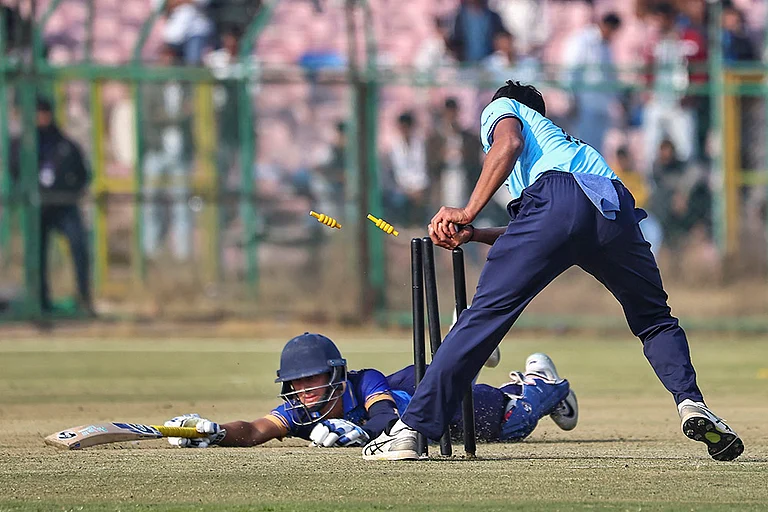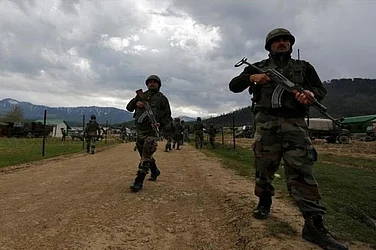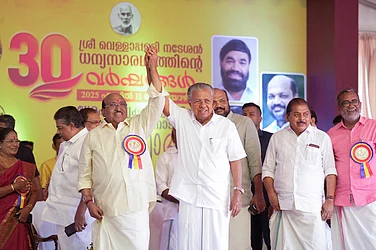The ’98 tally: BJP - 20
Next best party: RJD - 17
Gherabandi chal rahi hai yahan," grins Laloo Yadav. They are all trying to surround me, he says, so let the people decide. Whatever the outcome, the mobilisation of the anti-Laloo front in Bihar (the BJP, Samata and Janata Dal coming together) has certainly ensured one thing: Laloo could be facing the toughest battle yet of his political career. That he might still manage to hold on is an eloquent testimony to his staying powers and his complete understanding of that curious chemistry called elections.
But the odds seem stacked against him. In Bihar’s caste maelstrom, the upper castes are against him, as are some of the backwards. This time around there is an additional factor as well: sections of the Dalits—who are being promised liberation by Ram Vilas Paswan—might go along with the nda combine. One could, perhaps, surmise that for Laloo, the waters are literally rising—the precarious flood situation in north Bihar, Laloo’s real bastion, has party workers worried as casting votes could become a real problem if the waters don’t recede in time. But then, what he has going for him is the formidable Yadav-Muslim combine and an uncanny ability to know what people want.
In any case, it’s clear that the new alliances could prove to be more than just troublesome for the rjd strongman. Nothing epitomised that equation better than when, last week, Paswan went to file his nomination from Hajipur. By any yardstick, it was an impressive show. A cavalcade of cars and trucks, thousands of festoons, practically half the town out on the road—the procession was a riot of saffron and green. In attendance were George Fernandes, Nitish Kumar, Sharad Yadav, the BJP’s Sushil Modi and a host of influential local leaders. While Samata’s Raghunath Jha promised that "this time it’s going to be like ’77", Fernandes was happy to point out that the public reaction told its own story. A day before, when Nitish filed his nomination from Barh, that event too had turned out to be an occasion in itself. The calculation adopted by some nda leaders is based on simple arithmetic. They say that in ’98 most rjd candidates—including Laloo himself from Madhepura—won by relatively slender margins. "In most of these constituencies, the Janata Dal vote—which often polled over a lakh—went abegging. Now all these votes are coming into the nda fold," claims Paswan, quoting figures from a survey published by the Election Commission (EC) on the ’98 general elections.
To be sure, the nda combine does have its fissures, which are brought into sharp relief every now and then. Ramjivan Singh, a veteran Socialist who’d taken the lead in exposing the fodder scam, quit on grounds that claims of senior leaders in the jd(u) were ignored. Another nda member, Ramesh Prasad Singh, wrote a strong letter to Fernandes asking him "how only turncoats were getting tickets", hinting broadly at new nda entrant Shyam Sunder Dheeraj being preferred over him from Begusarai. But if there’s anything that still holds them together, it is the fervent hope that this election could knock off Laloo from his pedestal. nda leaders are also keen to point out that more and more rjd members are willing to join the front. "The only reason we’ve not allowed them in is because we cannot give seats to everyone," says a leader, claiming that even some ministers in the Rabri cabinet are keen to cross over.
Laloo, on the other hand, has coolly distributed tickets, dictated his own to the Congress and decided on his allies—unfazed by the cleavages in the alliance he had forged, for instance the cpi’s angry exit after it was given only three seats, as against the eight it had demanded. The only other people he seemed to have no control over were his brothers-in-law, particularly Sadhu Yadav. But in a last-minute coup, he got controversial ex-MP Kali Prasad Pandey fielded from Gopalganj, the seat Sadhu Yadav coveted. The other strong claimant for that position, veteran Abdul Ghafoor who recently left the Samata to join rjd, too was left in the lurch.
But the key question is what happens on election day? The nda’s worries are understandable. According to Fernandes, while the Election Commission has all the time to hand out homilies every day, it has not taken cognisance of complaints filed by the nda on blatant poll irregularities. For instance, after the polls were announced, about 1,400 stolen ballot boxes were recovered from seven districts. When contacted, state election commissioner A.K. Basu only said that, "It’s an EC matter and is being investigated." Just how well Laloo is preparing for the elections can be gauged from the fact that just before polls were announced, 300 civil and police officers were transferred at levels right from the chief secretary down to block development officers (bdos).
Not that Laloo is dependent only on that. Despite renewed security threats, he remains accessible to the party worker and the general public. Last week, at a rally in Fernandes’ constituency Nalanda, he termed the Janata Dal as ‘Jantu’ (animal) Dal, propounded that the fight was against feudal and communal elements, that all anti-Mandal leaders have gathered on one platform—in short, the entire gamut of charges that may not contain anything spectacularly new but do leave an impact. The new element: what was the defence minister doing when Kargil happened?
For its part, the Congress—which local leaders say would have gained had it not made itself subservient to Laloo—remains a badly divided house. Says state media chief Ram Updesh Singh, a former civil servant: "Politically, it was a deft move to ally with Laloo, but organisationally perhaps not. This was a good opportunity to build the organisation afresh." State Congress president Sadanand Singh has practically retired from the campaign, aware of the fact that with only 14 seats to contest, party workers in the rest of the constituencies have nothing to do. Added to this are a spate of resignations by veteran Congressmen—the latest to quit was Dilkeshwar Ram, a party veteran who left saying that Sadanand Singh was ignoring the interests of Dalits in the party. Some, like Ram Updesh Singh, say that the alliance with Laloo could actually help the party. "There is no question of getting less than last time," he says, earmarking six to seven constituencies where they say the party is a surefire winner, improving on their ’98 tally of five seats. These include two in the BJP bastion of largely tribal south Bihar which goes to polls in the first phase on September 18.
The position of prominent central ministers in the BJP, however, remains safe. Yashwant Sinha from Hazaribagh has heavy-duty glamour in his favour—all other local issues have been given the go by in the run-up to the elections, and reports of near-zero percent inflation have also added to his persona. Fernandes too seems to be on a good wicket in Nalanda, with four lakh Kurmis plus a good number of Bhumihars waiting to vote for him, quite unfazed by talk that Admiral Bhagwat is landing there to campaign against him.But the BJP’s rising star Rita Verma has a battle on hand, contesting against A.K. Roy, a veteran of the Marxist Coordination Committee from Dhanbad, who has the support of not just his cadres but rjd and Congress activists as well.
The other interesting fight is anticipated at Madhepura where, like last time, Laloo takes on Sharad Yadav, amidst speculation that the Yadav-dominated constituency is waiting to teach Laloo a lesson. "This time it will be difficult for Laloo," predicts Sharad, saying that literally nothing has been done for the backward constituency and its people. The campaign is yet to take off in right earnest, with Laloo himself admitting that it’s too early. But with elections now coming every year, political parties seem to be banking on a late burst of campaigning which could well come during the last 10 days or so.


























